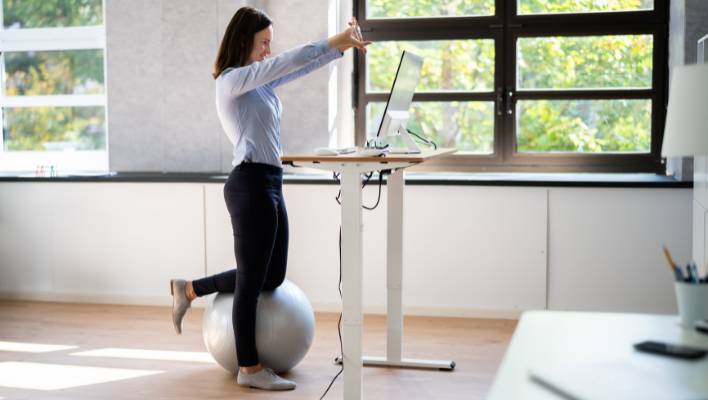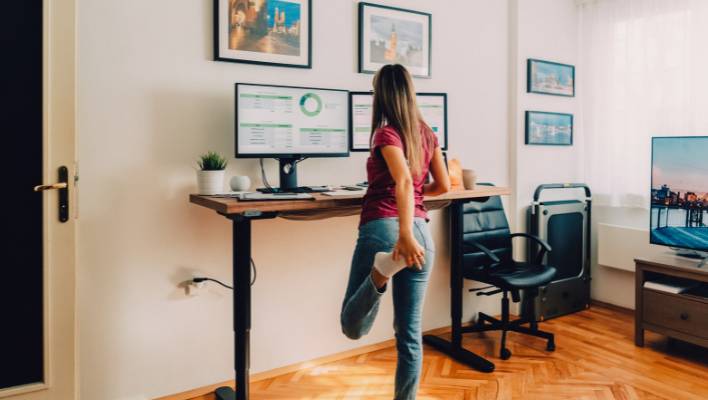Are Standing Desks Overrated?
The Popularity of Standing Desks
In recent years, standing desks have become a popular choice for those seeking a healthier work environment.
These desks allow users to stand while they work, rather than remain seated for extended periods of time.
The idea behind these desks is that standing burns more calories and promotes better posture and overall health.
As sitting for prolonged periods has been linked to various health problems, including obesity and back pain, it’s not surprising that many people are turning to standing desks as an alternative.
Miracle Solution or Overrated Fad?
While the benefits of using a standing desk are well-documented, some experts argue that they may be overrated.
It’s true that standing burns more calories than sitting; on average, someone who stands all day will burn about 170 more calories than someone who sits all day. However, this increased caloric burn may not be significant enough to make a real impact on weight loss or overall health.
Additionally, standing for long periods can lead to fatigue and discomfort in the feet and legs (especially if someone isn’t used to it!).
It’s also important to note that simply switching from a sitting desk to a standing desk is not enough to improve your health if you still maintain a sedentary lifestyle outside of work hours.
Ultimately, the key to optimal health is movement – whether it’s walking around the office every hour or taking breaks throughout the day to stretch and move your body in different ways.
The Benefits of Standing Desks
With the rise of sedentary jobs, the risk of obesity and its related diseases has increased as well. Standing desks have been pitched as a “quick fix” for these issues.
They are known to increase calorie burn slightly when compared to sitting. It’s unlikely that a standing desk will be a cure all for objesity.
That said, standing desks can have some significant benefits in other areas.
Goodbye Back Pain, Hello Good Posture
Sitting for long periods can cause back pain and poor posture. Standing desks offer a solution to this problem by allowing you to stand while working, which helps you maintain good posture and reduce the strain on your back.
Standing also engages more muscles than sitting alone, which can help strengthen your core muscles and improve overall posture. This is why standing desks are often recommended for people with lower back problems as they can help alleviate pain.
Boosting Energy Levels and Productivity
Standing up increases blood flow throughout the body which leads to better oxygenation of organs including your brain.
And when your brain is getting more oxygen, it means improved cognitive function leading to better productivity!
Standing up also promotes alertness and focus because it keeps you in an upright position that requires more effort compared with sitting down slouched over a computer screen all day long.
Some studies have suggested significant increases in cognitive function and memory for those using standing desks.
Even if you might be skeptical of these benefits, it’s likely worth giving one a try to see if they might make you feel better while working as well.
Of course, there are potential problems with standing desks.
Drawbacks of Standing Desks
Increased Risk of Varicose Veins and Foot Problems
While standing desks have been touted as a way to improve overall health, they can also lead to some negative consequences.
One major drawback of standing desks is the risk of developing varicose veins and foot problems for those at risk of having vein problems. When standing for prolonged periods, blood can pool in the legs and cause veins to swell, leading to varicose veins.
This condition can be painful and unsightly, but it can also lead to more serious health issues if left untreated.
In addition, standing for long periods puts a strain on the feet and can cause problems like plantar fasciitis or heel spurs.
Fatigue from Prolonged Standing Leading to Decreased Productivity
Another drawback of standing desks is that they may actually decrease productivity due to fatigue caused by prolonged standing.
While it is true that sitting for long periods has been linked to health problems like obesity and heart disease, standing for too long can also be detrimental.
Standing requires more energy than sitting, so it’s natural that a person will tire quicker when working at a standing desk versus a sitting one.
This fatigue can lead to decreased productivity later in the day as well as difficulty concentrating on tasks at hand.
Difficulty in Finding the Right Height for Desk and Monitor
One issue with standing desks is finding the right height for both the desk itself and any monitors or other equipment being used while standing.
If these items are not positioned correctly, it can lead to neck or back pain which defeats some of benefits of using a stand-up desk.
Another issue with finding suitable heights is that everyone’s body shape varies so it may be difficult find adaptions for an appropriate posture if you’re using someone else’s equipment in an office setting or shared workspace.
Some people may have to crane their necks to see a monitor that is too high, causing muscle strain and pain. On the other hand, if the monitor is too low, it can lead to hunching over and again cause pain in the neck and back.
The Importance of Movement

The Human Body is Designed for Movement, Not Static Positions
The human body is a remarkable machine. It has evolved over thousands of years to be highly adaptable and able to perform a wide range of physical activities.
Our bodies are not designed to sit or stand in one position for extended periods.
Our joints, muscles, and organs all function best when they are in motion. When we sit at a desk for long periods without moving, our muscles start to contract and weaken.
This can lead to poor posture, back pain, and even nerve damage.
Similarly, standing in one position for too long can put pressure on the feet and legs, leading to discomfort and even injury.
Alternating Between Sitting, Standing, and Walking Throughout the Day is a Good Strategy
The key to maintaining optimal health when you have to work at a desk is movement.
Alternating between sitting, standing, and walking throughout the day keeps our bodies active and prevents muscle fatigue or strain. One way to achieve this is by using a height-adjustable standing desk that allows you to change your position frequently during the day.
This will help you maintain good posture while also giving your legs a break from prolonged sitting (or standing).
Another approach is taking frequent breaks throughout the day to stand up and stretch or take a quick walk.
Even just five minutes of movement every hour can make a big difference in how your body feels by the end of the day.
While standing desks have many benefits such as improved posture and increased productivity if used correctly, they’re not an all-in-one solution towards optimal health.
Just focus on creating a balance that works well to you!
Alternatives to Standing Desks
While standing desks have become increasingly popular in recent years, they may not be the best option for everyone.
Fortunately, there are other alternatives to consider that provide similar benefits without the drawbacks often associated with standing desks. Here are two great options:
Active Sitting Chairs or Balance Balls
Active sitting chairs and balance balls are designed to provide a more dynamic sitting experience than traditional office chairs.
These types of chairs force you to engage your core and other muscles to maintain your balance, which can help improve your posture and reduce back pain.
They also encourage movement and can help prevent the stiffness that comes from prolonged sitting.
If you’re considering an active sitting chair or balance ball for your workspace, it’s important to note that they may take some getting used to at first.
You may need time to build up your core strength and get comfortable with the new style of seating.
Additionally, while these options can be great for short periods of work, they may not be ideal for longer sessions where you need more support.
Taking Frequent Breaks to Stretch or Walk Around
No matter what type of desk you use, taking breaks throughout the day is crucial for maintaining good health and productivity.
One easy way to do this is by taking brief breaks every hour or so to stretch or walk around.
This helps increase blood flow and oxygen levels in the body, which can boost energy and mental clarity.
If possible, try incorporating some light exercise into your breaks as well.
This could include yoga poses like downward dog or plank pose, simple stretches like toe touches or arm circles, or even a quick walk outside if weather permits.
Conclusion
Standing desks are a relatively new phenomenon that have become increasingly popular over the years. While some people swear by their standing desk, others find them to be overrated.
They can help improve posture and reduce back pain, which is a common complaint among office workers who sit for extended periods of time.
Additionally, standing desks can lead to increased energy levels and productivity.
On the other hand, there are also some drawbacks to using a standing desk. They can increase the risk of vein and foot problems due to prolonged standing.
Fatigue from prolonged standing can also lead to decreased productivity. It may also be difficult finding the right height for your desk and monitor.
In most cases, a mix between standing, sitting, and walking will yield the best results. Standing desks can be a helpful tool in that mix.
Ultimately, it’s all about finding the right balance that works for you and your unique needs.
And, especially if you have problems with chronic pain or some other issue, be sure to consult with a medical professional who can offer a solution tailored to your needs.
If you’re ready to start looking for a standing desk, check out our favorite options here.

